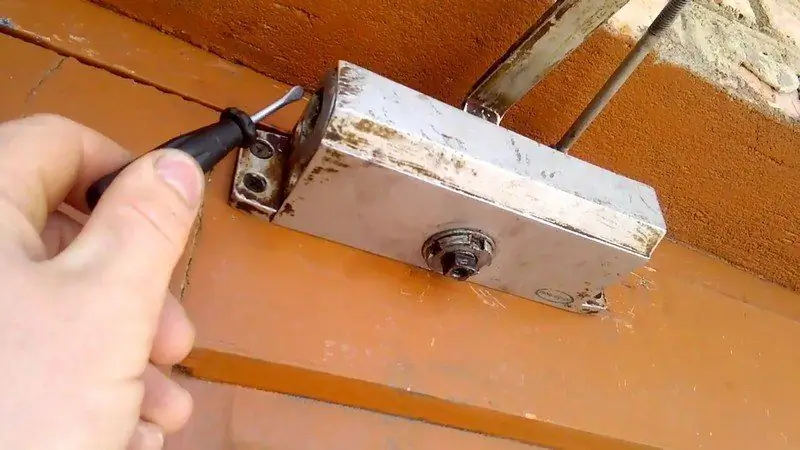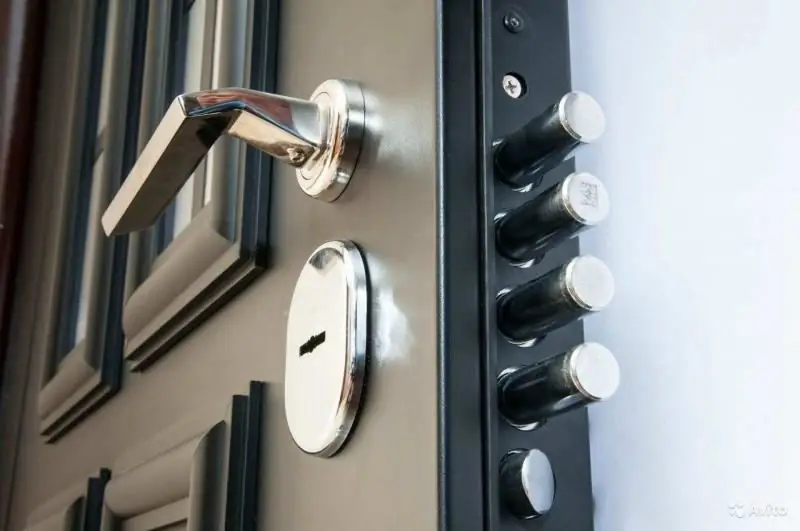
Table of contents:
- Author Bailey Albertson [email protected].
- Public 2023-12-17 12:53.
- Last modified 2025-01-23 12:41.
Urgently to the operating room: door faults and repairs

One can only dream of an indefinite service of things. Even the strongest doors, if used often, stop closing tightly, swell and creak. However, every problem with this piece of furniture is easily removable.
Content
- 1 The main reasons for door restoration
- 2 Tools and materials for door leaf repair
-
3 Ways to solve basic problems
-
3.1 Adjusting the doors
3.1.1 Video: detailed restoration of an old oak door
- 3.2 Door lubrication
- 3.3 Sealing holes
-
3.4 Painting the door
3.4.1 Video: how to paint the door correctly
-
- 4 Redecorating the door
The main reasons for door restoration
One of the following troubles can happen to the door:
-
Difficulty opening or closing due to swelling of the door material that has absorbed moisture;

Door opening If the door does not open and close well, then it is either swollen from dampness, or dry, or warped due to broken hinges
- jamming due to shrinkage of the house or a large gap between the canvas and the box from the side of the hinge attachment;
- loose fit to the frame as a result of drying out of the door material;
- alternating swelling and drying out due to seasonal temperature changes;
- subsidence caused by breakage of the hinges;
- squeak when opening, resulting from corrosion or breakage of the hinges;
- closing problem, because the door lock tongue has moved out of place relative to the special hole;
- the appearance of holes due to mechanical damage to the sash;
-
damage to paint that peels off on the surface of the product after many years of service;

Peeling paint door Over time, the paint peels off the door, which makes the product lose its attractive appearance
- deformation due to dampness.
Tools and materials for repairing a door leaf
In most cases, when restoring a door, the following are useful:
- screwdriver or screwdriver with self-tapping screws;
- plane and chisel;
- a hammer;
- hex and spanner keys;
- electric drill (for dismantling the lock fasteners and drilling holes for installing a new product);
- marker (to mark where holes are created);
- sandpaper (or a metal brush if the door is metal);
- roller, brushes and sponges for applying paint and removing excess paint;
- masking tape and primer (to prepare the product for painting);
- polyurethane foam;
- epoxy or polyester resin;
- putty (for a wooden sash);
- paint and varnish composition.
Basic troubleshooting methods
Most often, door repair is associated with adjusting the opening and closing mechanism of the sash, eliminating squeak, sealing holes and painting the canvas.
Door adjustment
In order to achieve easy door opening, first of all, you need to do the following:
- Remove the door leaf.
-
Cut off the protruding parts that are visible by the scraped off paint with a plane.

The process of planing a door with a plane The planer cut the swollen wood
- Sand the edges with sandpaper.
- See if the hinge fixation is loose.
- If necessary, strengthen the fastening by replacing the hinges with thicker or longer ones and tightening new screws, for which it is necessary to drill holes of the required diameter.
- Paint the doors and hang them on the hinges.
If you visually see that the door is skewed and because of this the canvas is jammed, you need to substitute a rubber gasket under one of the hinges. If the sash extends beyond the door frame with its lower part, then a piece of cloth should be placed under the upper fastener. And when the door does not fit into the door frame at the top, the gasket must be made for the lower hinge.

By placing a piece of rubber under the hinge, you can get rid of the skew of the door
If a too large gap is found between the sash and the frame on the side of the hinges, it is necessary to deepen their seats in order to "drown" the hinges in the door frame.

By making deeper holes for the hinges, you can reduce the gap between the frame and the canvas
If the door is not skewed, but does not close tightly, you need to:
-
Cut a strip of rubber, leather or wood for the end of the door.

Rubber strip for door With a piece of rubber at the end, the door will close tightly
- Nail a piece of fabric with nails.
- Sand, putty and paint the end of the door (if a wooden plate was used).
If the wooden sash either swells or dries up, its thickness is adjusted as follows:
- A layer of wood is cut off from the swollen door.
- When the sash dries out, a gasket is cut out for it. To do this, take sheet copper or brass, the length of which is 2 times the thickness of the door, and the width is 4.5 cm.
- The metal plate is fixed with screws in the central part of the end of the door, bent, placing cardboard under it, and pressed. The plate will act as a regulator of the door thickness. Regardless of the season, the flap will always be tightly closed.
When deforming a wooden door, upholstered with slats, due to exposure to moisture, you need:
- Remove the door leaf and place it on a flat horizontal surface.
- Mark where the wood is damaged.
-
Remove damaged boards or panels by removing fasteners and milled frames.

Dismantling a wooden door Damaged panels are removed after dismantling the milled frames
- Replace deformed elements with new ones.
- Boards that for some reason could not be removed should be leveled with a mallet.
Video: detailed restoration of an old oak door
Door grease
Doors that squeak need lubrication. It usually occurs due to:
- disappearance of grease on the hinges after a long service of the door;
- rusting of the hinges (most often occurs with entrance doors);
- wear of hinges that were not treated with lubricant in time;
- debris falling into the hinges;
- sash skew, provoking friction of the sash against the frame.
It is advisable to process door hinges:
- aerosol WD-40, which fights against corrosion and envelops the surface with a thin film that improves sliding;
- lithol, characterized by resistance to cold and moisture;
-
grease, which is considered a universal lubricant;

Solidol Solidol ensures soft and quiet functioning of the hinges
- cyatim, which is a thick oil mixed with antioxidants;
- special oil for sewing machines;
- graphite shavings made from a pencil rod.
It is better to squeeze out the hinge lubricant from a syringe or oiler. But when disassembled, it is wiser to process the loop with a sponge or a thin brush. Remove excess grease with a dry cloth.
Sealing holes
To close a hole in a fiberboard door, you need:
- With a drill with a drill with a diameter of 3-4 mm or a construction knife, make neat holes in the leaky places of the door.
-
Pull the deflection outward with a metal hook, joining the torn edges.

Dent in a wooden door To make the dent disappear, you need to hide the paper in it.
- Push the paper into the hole and squeeze out a little polyurethane foam, which will not allow the torn pieces to fall into the door leaf.
- Treat the torn edges with PVA glue and carefully connect.
- Carefully cut off excess polyurethane foam, leveling the surface.
- Apply some resin or PVA glue to the repaired area to give the loose foam strength.
-
Spread a thin layer of wood putty on top of the hardened resin. When it hardens, rub the repaired area with fine sandpaper and prime with a primer.

Putty application After the glue or resin has hardened, the place around the defect is treated with wood putty
- Paint the entire door or stick it on an area where there used to be a hole, mirror or poster.
Door painting
A door that needs restoration is painted in stages:
- The canvas is removed from its hinges and placed on the cardboard floor or on a large table.
- Dismantle the handle, lock and the rest of the fittings.
-
After slightly moistening and heating the surface with a building hair dryer, scrape off the old layer of paint with a spatula.

Old paint removal process The old paint is removed, simultaneously acting with a building hair dryer and a spatula
- The cleaned cloth is sanded with fine-grained sandpaper. If it is metal, then rust is removed from it. To do this, use a metal brush or a mixture of lemon and vinegar.
- Recesses and other defects are hidden with putty.
- The dried composition is carefully rubbed with fine-grained emery paper, eliminating irregularities.
- The door leaf is coated with a primer.
- Use a hard small brush to paint small details and hard-to-reach places.
-
Using a roller or large brush, spread the paint over the entire surface of the door, starting from the upper corner in the direction from left to right.

Door painting process The paint is applied from left to right and from top to bottom
- When the painted surface is dry, the door is turned over. The paint is applied to the other side of the canvas.
- The layer of the coloring emulsion is sanded with sandpaper. The door is re-painted to obtain a rich color.
Video: how to paint the door correctly
Door redecoration
Redecorating the door is reduced to the elimination of visible flaws and renewal of the paint layer. It helps to extend the life of the product and helps to avoid the occurrence of serious defects.
To eliminate the problem of peeling veneer, timber and paint, you must:
-
Remove the door from its hinges and remove all the veneer with a chisel and spatula.

Veneer removal process Since the veneer began to flake off, it was completely removed
- Scrape off the remains of the old paint with a metal brush.
- Sand the cleaned product with sandpaper.
-
The bar, which began to separate from the rest of the structure, having previously drilled holes in it, connected to the frame with self-tapping screws and a countersunk head.

The process of attaching the detached timber The separated timber is connected to the rest of the door with self-tapping screws
-
Using small screws, attach the peeling hardboard to the door.

The process of fixing hardboard To fix the hardboard, use short self-tapping screws
- Cover the door leaf with acrylic primer and paint with two coats of paint.
For minor scratches, use furniture wax. Instructions for its use are usually indicated on the packaging.
If chipped, deep scratched or cracked:
- Degrease the damaged area.
- Sand the surface of this area with emery paper (P60-P80).
- Fill the cracks with a putty and level the area with the defect.
- Let the putty dry.
- Sand the area again (first with P100-P120, then P200-P240).
- Prime the surface.
- Apply paint, and after drying, varnish. Choose paint to match the wood or use a base in combination with varnish.
So, any problem with the door can be solved. This does not require any fundamental changes. It will be possible to put the door in order by picking up several tools and doing the work in accordance with the instructions given in our article.
Recommended:
Aluminum Doors: Types, Features Of Manufacture And Installation, As Well As Repair And Adjustment Of Faults

Technical characteristics and design features of aluminum doors. Applications and modifications. Installation work for the installation of an aluminum door
Repair Of Wooden Doors, What To Do In Case Of Breakdown And How To Fix The Malfunction Yourself

What door faults can be eliminated by hand and the technology of repairing the structure. Features of adjustment and restoration of a solid structure
Do-it-yourself Front Door Repair, As Well As How To Adjust And Restore Them

How to adjust the front door and fix various breakdowns. What tools and materials are needed. Do-it-yourself repair and restoration of the front door
Door Closer Repair: What Malfunctions You Can Fix Yourself And How To Do It Correctly

Self-elimination of door closer breakdowns. Features of adjusting the mechanism and the procedure for replacing it
Repair Of Door Locks: What Malfunctions You Can Fix Yourself And How To Do It Correctly

Types of door locks. Possible causes of breakdowns and ways to eliminate them. Defect search algorithm. Step-by-step instructions for replacing different types of locks
